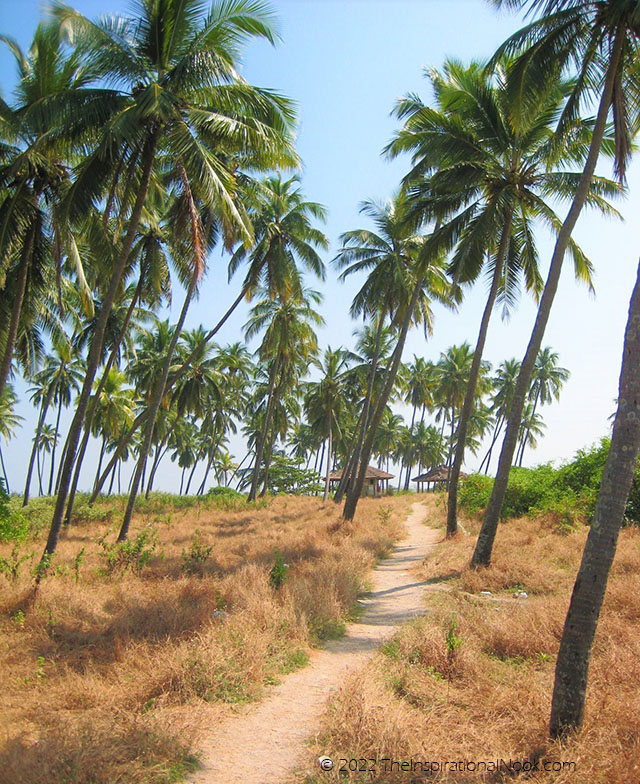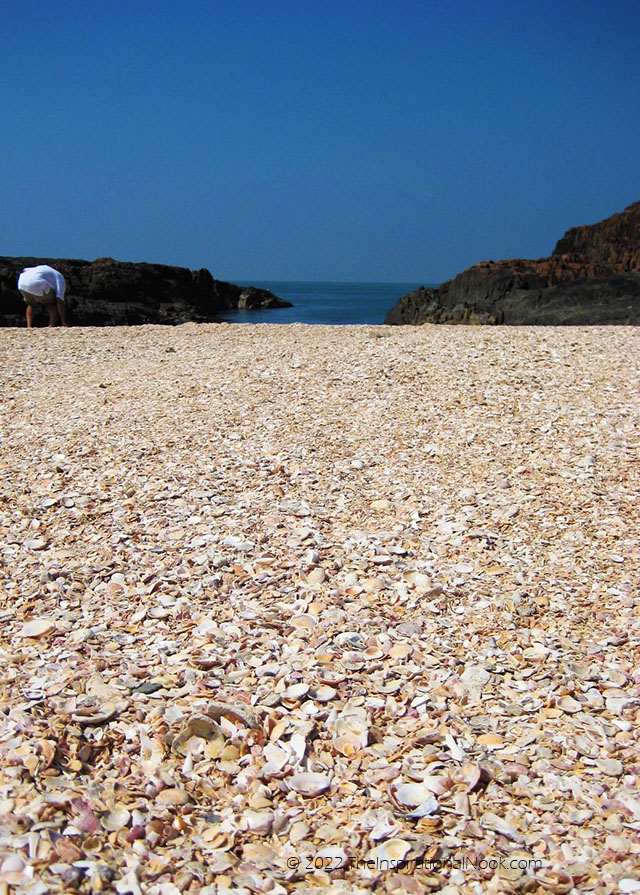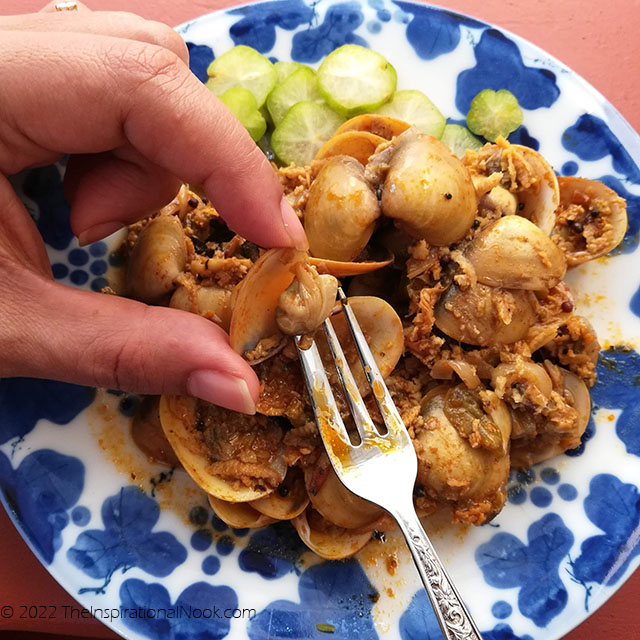Mangalorean Kube Sukke | Cockles and Clams from Coconut Island
Mrs. Robinson Crusoe? Or Mrs. Vasco da Gama? Who would I rather be? I mulled over the question as I gazed out at the expanse of azure Arabian sea before me. My fantasy of getting marooned on a deserted island was coming true.
I think Mrs.Vasco da Gama suited me better. After all, back in 1498 Vasco da Gama had landed on these very islands off the coast of Malpe, in Udupi, Karnataka. The story goes that he affixed a cross on these islands and named them 'O Padrao de Santa Maria' in Portuguese, before sailing on toward the Malabar coast.
Oh yes, I could so survive on this island. I leaped off the basaltic rock and into the warm water to grab at a fast disappearing clam before it buried itself into the white sand. Got it! I dragged my finger nail over the ridged surfaces of the two tightly shut shells and took a closer look. Ah, this one was perfectly heart shaped when viewed from the side. Not a clam, but a cockle then. My two years of studying zoology was finally coming to some use. I carefully placed my cockle in my hat along with my other foraged cockles and clams (locally known as kubes).
See, I could cook these for Da Gama and his crew and we could have a very nice seafood dinner indeed. Why did they always make it out to be so difficult to catch seafood on a deserted island? Not difficult at all, I surmised, as I turned away from the glittering sea and faced the gorgeous coconut tree coastline of 'O Padrao de Santa Maria', or St. Mary's Island, also known as Coconut Island for good reason.
 |
| St. Mary's Island or Coconut Island off the coast of Malpe, Karnataka, India. |
It had been quite an exhilarating trip getting here. After leaving Malpe on a large ferry, we made our journey out into the vast Arabian Sea. Oh glory! How I felt when I spotted St. Mary's islands on the horizon! Luckily, I wasn't in the crow's nest or I might have toppled out. The adventure was just beginning. Little did I know we would need to transfer in the middle of the ocean without a gang plank, onto a tiny little dinghy that rose and fell with every wave. And there were a lot of waves.
Then we puttered along in our little boat and tried to get as close as possible to Coconut Island. With no jetty or boat landing on the island, our dinghy stopped 25m from shore and we were instructed to jump out and wade through the water to make it to land. A soggy, wet landing, just like you see in the movies. But very refreshing, especially if you want to feel like an 18th century adventurer.
The next few hours were spent exploring the lovely St. Mary's Island and pretending I was Mrs. Vasco da Gama. Known for its distinctive geological formations of hexagonal columnar, basaltic rock, these rock formations on St. Mary's Island are one of the 34 National Geological Monuments of India and are a spectacular sight. Formed millions of years ago, it puts our blip of time on this earth in perspective and is a humbling experience.
 |
| Hexagonal, columnar, basaltic rock pillars on St. Mary's Island, Udupi, Karnataka. |
 |
| Seashell beach, St. Mary's Island, Udupi, Karnataka |
Hunger pangs soon made me focus, but only briefly as the beautiful scenery kept distracting me. What a beautiful, deserted island. Why would Da Gama ever have wanted to leave. I could picture myself staying here forever, perhaps building a nice little house under that overhang. And that's probably why Da Gama never sailed with his wife. He wouldn't have got very far with his explorations.
"Let's go," my husband yelled out to me, breaking my reverie.
"The last boat leaves in five minutes. And if we're not on it, we'll need to spend the night here."
I hustled. Adventurer that I was, I didn't fancy roughing it out alone on a dark, uninhabited island overnight. I looked down into my hat at the handful of cockles and clams that I had collected. Definitely not enough for dinner. Once we get to the mainland, I'd better stop at the fish market in Malpe and buy some more kubes, or else this Mangalorean cockle and clam dish is just not happening tonight.
Thinking of visiting?: A Travel Guide to St. Mary's Island, Udupi
 |
| Mangalorean cockles and clams, cooked with bimlis and best enjoyed with some cashew feni. |
Kube Sukke | Expert Tips for Mangalorean Cockles and Clams with Coconut
Kube Sukke is a Mangalore special made with cockles and clams (locally known as kubes), cooked in a baffad and coconut masala into a spicy, dry/ sukka dish. This recipe uses a local, sour fruit called bimlis.
 |
| Kube sukke |
Kubes live just below the low tide level, shallowly buried in sandy beaches and can be collected by raking the sands at low tide.
The best time to eat kubes is in months that have a 'r' in it. Stay away from eating them in May, June, July, August, since this is rainy season and kubes are not easy to procure during this time. Bimlis are not in season either during these monsoon months.
When making dishes using kubes, be sure to eat them within a day of cooking.
Cockles or Clams
Either cockles or clams can be used in this shell fish sukka recipe. How do you tell the difference between these two bivalve mollusks?
A true cockle, when viewed from the side, has a perfectly symmetrical, heart shaped structure. And the textured, ribbed shells of most cockles is also an easy distinguishing factor from its smooth shelled distant cousin, the clam.
 |
| Heart shaped cockle |
Cockles are also knows as heart clams and belong to the family Cardiidae and genus Cardium (meaning heart).
Recipe for Kube Sukke or Mangalorean Clams Sukka
Ingredients:
☐ Mustard seeds
☐ 6-7 Garlic pods
☐ Curry leaves
☐ 1 red onion, minced
☐ 8 bimlis, sliced
☐ 1 teaspoon baffad powder
☐ Freshly grated coconut
Step by Step Instructions:
Step 1: Prep
- Soak cockles in water.
- Mince onions and slice bimlis.
Step 2: Bagar Masala
- For the bagar, in a wok/ deep pan, heat oil. Add mustard seeds and wait for it to splutter.
- Add smashed garlic, curry leaves and minced red onion. Fry until the onions soften.
- Then add the slicked bimlis and baffad powder. Lower heat and add a little water to prevent the masala from burning.
Step 3: Cook Cockles/ Mussels/ Kubes
- Add the cockles/mussels/ kubes. Mix. Cover with a lid and steam on medium heat.
- Once cockles open, add grated coconut and salt.
Related Recipes:
Or visit My Cookbook Index for a full menu of my other delicacies.

